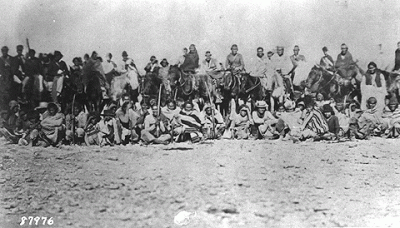Death march
A death march is a forced march of prisoners of war or other captives or deportees in which individuals are left to die along the way.[1] It is distinguished in this way from simple prisoner transport via foot march. Article 19 of the Geneva Convention requires that prisoners must be moved away from a danger zone such as an advancing front line, to a place that may be considered more secure. It is not required to evacuate prisoners that are too sick or injured to move. In times of war such evacuations are not carried out without difficulty.
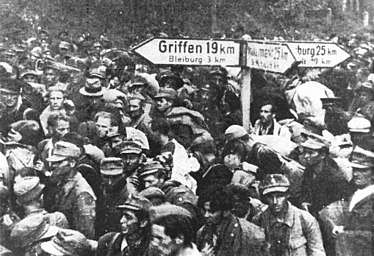
Death marches usually feature harsh physical labor and abuse, neglect of prisoner injury and illness, deliberate starvation and dehydration, humiliation and torture, and execution of those unable to keep up the marching pace. The march may end at a prisoner-of-war camp or internment camp, or it may continue until all the prisoners are dead (a form of "execution by labor", as seen in the Armenian genocide, among other examples).
General Masaharu Homma was charged with failure to control his troops in 1945 in connection with the Bataan Death March.[2][3]
Examples
Before World War II
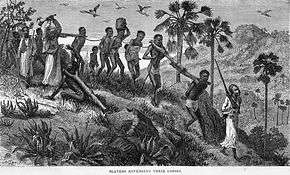
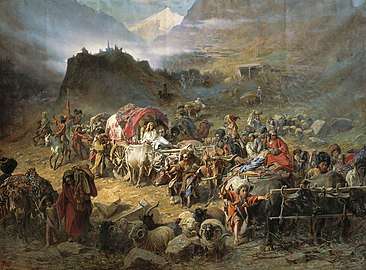
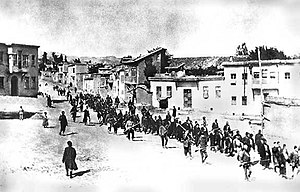
- Forced marches were utilized for slaves who were bought or captured by slave traders in Africa. They were shipped to other lands as part of the East African slave trade with Zanzibar and the Atlantic slave trade. The merchants sometimes shackled them and didn't give enough food. Slaves who became too weak to walk were often killed or left to die.[4][5]
David Livingstone wrote of the East African slave trade:
We passed a slave woman shot or stabbed through the body and lying on the path. [Onlookers] said an Arab who passed early that morning had done it in anger at losing the price he had given for her, because she was unable to walk any longer.[6]
- As part of Indian removal in the United States, in 1831, approximately 6,000 Choctaw were forced to leave Mississippi for Oklahoma, and only about 4,000 of them arrived in 1832.[7]
- In 1836, after the Creek War, the United States Army deported 2,500 Muskogee from Alabama in chains as prisoners of war.[8] The rest of the tribe (12,000) followed, deported by the Army. Upon arrival in Oklahoma, 3,500 died of infection.[9]
- In 1838, the Cherokee nation was forced by order of President Andrew Jackson to march westward towards Oklahoma. This march became known as the Trail of Tears: an estimated 4,000 men, women, and children died during relocation.[10]
- When the Round Valley Indian Reservation was established, the Yuki people (as they came to be called) of Round Valley were forced into a difficult and unusual situation. Their traditional homeland was not completely taken over by settlers as in other parts of California. Instead, a small part of it was reserved especially for their use as well as the use of other Indians, many of whom were enemies of the Yuki. The Yuki had to share their home with strangers who spoke other languages, lived with other beliefs, and who used the land and its products differently. Indians came to Round Valley as they did to other reservations - by force. The word "drive", widely used at the time, is descriptive of the practice of "rounding up" Indians and "driving" them like cattle to the reservation where they were "corralled" by high picket fences. Such drives took place in all weather and seasons, and the elderly and sick often did not survive. (Part of California Genocide)
- Long Walk of the Navajo
- In August 1863 all Konkow Maidu were to be sent to the Bidwell Ranch in Chico and then be taken to the Round Valley Reservation at Covelo in Mendocino County. Any Indians remaining in the area were to be shot. Maidu were rounded up and marched under guard west out of the Sacramento Valley and through to the Coastal Range. 461 Native Americans started the trek, 277 finished.[11] They reached Round Valley on 18 September 1863. (Part of California Genocide)
- The Circassian genocide was the Russian Empire's ethnic cleansing, killing, forced migration,[12] and expulsion of the majority of the Circassians from their historical homeland Circassia, which roughly encompassed the major part of the North Caucasus and the northeast shore of the Black Sea. This occurred in the aftermath of the Caucasian War in the last quarter of the 19th century.[13] The displaced people moved primarily to the Ottoman Empire. An unknown number of deportees perished during the process. Some died from epidemics among crowds of deportees both while awaiting departure and while languishing in their Ottoman Black Sea ports of arrival. Others perished when ships underway sank during storms.[14] Calculations including those taking into account the Russian government's own archival figures have estimated a loss of 90%,[15] 94%,[16] or 95%–97%[17] of the Circassian nation in the process (see Circassian diaspora). The Circassians in Turkey are one of the largest ethnic minorities in Turkey.
- After the Yavapai Wars 375 Yavapai perished in Indian Removal deportations out of 1,400 remaining Yavapai.[18][19]
- The Armenian Genocide resulted in the death of up to 1,500,000 people from 1915–1918. Under the cover of World War I, the Young Turks sought to cleanse Turkey of its Armenian population. As a result, much of the Armenian population was exiled from large parts of Western Armenia and forced to march to the Syrian Desert.[20] Many were raped, tortured, and killed on their way to the 25 concentration camps set up in the Syrian Desert. The most famous camp was that of Der Zor where an estimated 150.000 Armenians were killed.[21]
- Grand Duke Nicolas (who was still commander-in-chief of the Western forces), after suffering serious defeats at the hands of the German army, decided to implement the decrees for the German Russians living under his army's control, principally in the Volhynia province. The lands were to be expropriated, and the owners deported to Siberia. The land was to be given to Russian war veterans once the war was over. In July 1915, without prior warning, 150,000 German settlers from Volhynia were arrested and shipped to internal exile in Siberia and Central Asia. (Some sources indicate that the number of deportees reached 200,000). Ukrainian peasants took over their lands. The mortality rate from these deportations is estimated to have been 63,000 to 100,000, that is from 30% to 50%, but exact figures are impossible to determine.
- In the eastern part of Russian Turkestan, after the suppression of the Urkun uprising against the Russian Empire tens of thousands of surviving Kyrgyz and Kazakhs fled toward China. In the Tien-Shan Mountains they died by the thousands in mountain passes over 3,000 meters high.[22]
During World War II
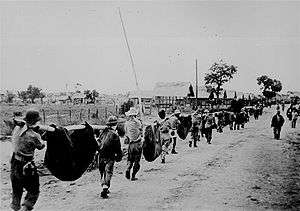
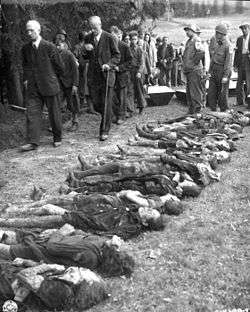
During World War II, death marches of POWs occurred in both Nazi-Occupied Europe and the Japanese Empire. Death marches of Jews were common in the later stages of The Holocaust as the Allies closed in on concentration camps in occupied Europe.
- During Operation Barbarossa, particularly during 1941–42 when large numbers of Soviet prisoners were captured, death marches were among the forms of German mistreatment of Soviet prisoners of war. Considered to be a German war crime.
- After the Battle of Stalingrad in February 1943, many German prisoners of war were left to die on march.[23] After the initial captivity near Stalingrad they were sent on a "death march across the frozen steppe" to labor camps elsewhere in the Soviet Union.[24]
- In the Pacific Theatre, the Imperial Japanese Army conducted death marches of Allied POWs, including the infamous Bataan Death March (1942) and the Sandakan Death Marches (1945). The former forcibly transferred 60-80,000 POWs to Balanga, resulting in the deaths of 2,500–10,000 Filipinos and 100–650 Americans, the latter causing the deaths of 2,345 Australians and British, of which only 6 survived. Both the Bataan and Sandakan death marches were judged as war crimes.
- The term "death march" was used in the context of the World War II history by victims and then by historians to refer to the forcible movement between fall 1944 and April 1945 by Nazi Germany of thousands of prisoners, from Nazi concentration camps near the advancing war fronts to camps inside Germany under the requirement of Article 19 of the Geneva Convention. One infamous death march occurred in January 1945, as the Soviet Red Army advanced on occupied Poland. Nine days before the Soviets arrived at the death camp at Auschwitz, the SS marched nearly 60,000 prisoners out of the camp towards Wodzisław Śląski (German: Loslau), 35 miles away, where they were put on freight trains to other camps. Approximately 15,000 prisoners died on the way.[25][26] The death marches were judged as a crime against humanity.
- Population transfer in the Soviet Union refers to forced transfer of various groups from the 1930s up to the 1950s ordered by Joseph Stalin and may be classified into the following broad categories: deportations of "anti-Soviet" categories of population (often classified as "enemies of workers"), deportations of entire nationalities, labor force transfer, and organized migrations in opposite directions to fill the ethnically cleansed territories. Soviet archives documented 390,000[27] deaths during kulak forced resettlement and up to 400,000 deaths of persons deported to Forced settlements in the Soviet Union during the 1940s;[28] however Steven Rosefield and Norman Naimark put overall deaths closer to some 1 to 1.5 million perishing as a result of the deportations — of those deaths, the deportation of Crimean Tatars and the deportation of Chechens were recognized as genocides by Ukraine and the European Parliament respectively.[29][30][31][32]
After World War II
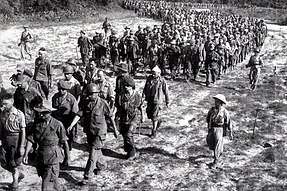
- Brno death march during the expulsion of Germans from Czechoslovakia in May 1945.
- Bleiburg repatriations, 1945 (during the last days of World War II and after), 280,000 Croats,[33] mostly ustashe and domobrans, but also civilians and refugees, were forced to march through Bosnia and Herzegovina, Croatia, Slovenia and Austria, where British soldiers handed them over to Partizans. Then they had to march again to Croatia, Bosnia and Herzegovina or even to North Macedonia.[34]
- During the 1948 Arab–Israeli War, some 70,000 Palestinian Arabs from the cities of Ramle and Lydda were forcibly expelled by Israeli forces. The event has come to be known as the Lydda death march.[35]
- During the Korean War, in the winter of 1951, 200,000 South Korean National Defense Corps soldiers were forcibly marched by their commanders, and 50,000 to 90,000 soldiers starved to death or died of disease during the march or in the training camps.[36] This incident is known as the National Defense Corps Incident.
- During the Korean War, prisoners who were held by the North Koreans underwent what became known as the "Tiger Death March". The march occurred while North Korea was being over-run by United Nations forces. As North Korean forces retreated to the Yalu River on the border with China, they evacuated their prisoners with them. On 31 October 1950, some 845 prisoners, including about eighty noncombatants, left Manpo and went upriver, arriving in Chunggang on 8 November 1950. A year later, fewer than 300 of the prisoners were still alive. The march was named after the brutal North Korean colonel who presided over it, his nickname was "The Tiger". Among the prisoners was George Blake, an MI6 officer who had been stationed in Seoul. While he was being held as a prisoner, he became a KGB double agent.[37]
- The 1975 forced evacuation of Phnom Penh in Cambodia by the Khmer Rouge
See also
References
- "Definition of DEATH MARCH". www.merriam-webster.com.
- Steiner, K., Lael, R. R., & Taylor, L. (1985). War Crimes and Command Responsibility: From the Bataan Death March to the MyLai Massacre. Pacific Affairs, 58(2), 293.
- Maguire, Peter. Law and War: International Law and American History. Columbia University Press (2010), 108
- Falola, Toyin; Warnock, Amanda (2007). Encyclopedia of the Middle Passage. Greenwood Publishing Group. p. 97. ISBN 978-0-313-33480-1. OCLC 230753290.
- Friedman, Saul S (2000). Jews and the American Slave Trade. Transaction Publishers. p. 232. ISBN 978-1-4128-2693-8.
- Livingstone, David (2006). The Last Journals of David Livingstone, in Central Africa, from 1865 to His Death. Echo Library. p. 46. ISBN 1-84637-555-X.
- "Trail of Tears". Choctaw Nation. Archived from the original on 2016-03-12.
- Foreman, Grant (1974) [1932]. Indian Removal: The Emigration of the Five Civilized Tribes of Indians. University of Oklahoma Press. Archived from the original on April 13, 2012.
- "Creeks". Everyculture.com.
- Marshall, Ian (1998). Story line: exploring the literature of the Appalachian Trail (Illustrated ed.). University of Virginia Press. ISBN 978-0-8139-1798-6.
- Dizard, Jesse A. (2016). "Nome Cult Trail". ARC-GIS storymap. technical assistance from Dexter Nelson and Cathie Benjamin. Department of Anthropology, California State University, Chico – via Geography and Planning Department at CSU Chico.
- Coverage of The tragedy public Thought (later half of the 19th century), Niko Javakhishvili, Tbilisi State University, 20 December 2012,
- Yemelianova, Galina, Islam nationalism and state in the Muslim Caucasus. April 2014. pp. 3
- King, Charles. The Ghost of Freedom: A History of the Caucasus.
- Barry, Ellen (20 May 2011). "Georgia Says Russia Committed Genocide in 19th Century". The New York Times.
- Sarah A.S. Isla Rosser-Owen, MA Near and Middle Eastern Studies (thesis). The First 'Circassian Exodus' to the Ottoman Empire (1858–1867), and the Ottoman Response, Based on the Accounts of Contemporary British Observers. Page 16: "... with one estimate showing that the indigenous population of the entire north-western Caucasus was reduced by a massive 94 per cent". Text of citation: "The estimates of Russian historian Narochnitskii, in Richmond, ch. 4, p. 5. Stephen Shenfield notes a similar rate of reduction with less than 10 per cent of the Circassians (including the Abkhazians) remaining. (Stephen Shenfield, "The Circassians: A Forgotten Genocide?", in The Massacre in History, p. 154.)"
- Richmond, Walter. The Circassian Genocide. Page 132: ". If we assume that Berzhe’s middle figure of 50,000 was close to the number who survived to settle in the lowlands, then between 95 percent and 97 percent of all Circassians were killed outright, died during Evdokimov’s campaign, or were deported."
- Immanuel, Marc. "The Forced Relocation of the Yavapai".
- Mann, Nicholas (2005). Sedona, Sacred Earth: A Guide to the Red Rock County. Light Technology Publishing. p. 20. ISBN 978-1-62233-652-4.
- "Exiled Armenians Starve in the Desert". The New York Times. Boston. August 8, 1916.
- Winter, Jay, ed. (2004-01-08). "America and the Armenian Genocide of 1915". doi:10.1017/cbo9780511497605. Cite journal requires
|journal=(help) - Bruce Pannier (2 August 2006). "Kyrgyzstan: Victims Of 1916 'Urkun' Tragedy Commemorated". RFE/RL.
- Beevor, Antony (1998). "25 The Sword of Stalingrad". Stalingrad. London: Viking. ISBN 978-0-14-103240-5.
- Griess, Thomas E. (2002). The Second World War: Europe and the Mediterranean (The West Point Military History Series). West Point Military Series; First Printing edition. p. 134. ISBN 978-0757001604.
- "Death marches". United States Holocaust Memorial Museum. Archived from the original on 2009-08-25.
- Gilbert, Martin (May 1993). Atlas of the Holocaust (Revised and Updated ed.). William Morrow & Company. ISBN 0688123643. (map of forced marches)
- Pohl, J. Otto (1997). The Stalinist Penal System. McFarland. p. 58. ISBN 0786403365.
- Pohl, J. Otto (1997). The Stalinist Penal System. McFarland. p. 148. ISBN 0786403365. Pohl cites Russian archival sources for the death toll in the special settlements from 1941-49
- "UNPO: Chechnya: European Parliament recognises the genocide of the Chechen People in 1944". unpo.org.
- Naimark, Norman M (2011). Stalin's Genocides. Human Rights and Crimes Against Humanity. Princeton University Press. p. 131. ISBN 978-0-691-14784-0. OCLC 587249108.
- Rosefielde, Steven (2009). Red Holocaust. Routledge. p. 84. ISBN 978-0-415-77757-5.
- "Ukraine's Parliament Recognizes 1944 'Genocide' Of Crimean Tatars". RadioFreeEurope/RadioLiberty.
- Corsellis, John, & Marcus Ferrar. 2005. Slovenia 1945: Memories of Death and Survival After World War II. London: I.B. Tauris, p. 204.
- Vuletić, Dominik (December 2007). "Kaznenopravni i povijesni aspekti bleiburškog zločina". Lawyer (in Croatian). Zagreb, Croatia: Pravnik. 41 (85): 125–150. ISSN 0352-342X. Retrieved 24 March 2015.
- Holmes, Richard; Strachan, Hew; Bellamy, Chris; Bicheno, Hugh (2001). The Oxford companion to military history (Illustrated ed.). Oxford University Press. p. 64. ISBN 9780198662099.
On 12 July, the Arab inhabitants of the Lydda-Ramle area, amounting to some 70,000, were expelled in what became known as the 'Lydda Death March'.
- Terence Roehrig (2001). Prosecution of Former Military Leaders in Newly Democratic Nations: The Cases of Argentina, Greece, and South Korea. McFarland & Company. p. 139. ISBN 978-0-7864-1091-0.
- Lewis H Carlson (2002). Remembered Prisoners of a Forgotten War: An Oral History of Korean War POWs. St Martin's Press. pp. 49–50, 60–62. ISBN 0-312-28684-8.
